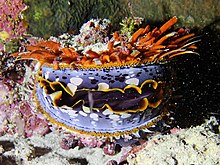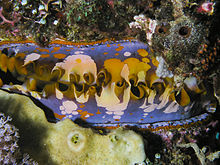Spondylus
| Spondylus Temporal range:
| |
|---|---|

| |
| A shell of Spondylus regius | |
| Scientific classification | |
| Domain: | Eukaryota |
| Kingdom: | Animalia |
| Phylum: | Mollusca |
| Class: | Bivalvia |
| Order: | Pectinida |
| Superfamily: | Pectinoidea |
| Family: | Spondylidae Gray, 1826 |
| Genus: | Spondylus Linnaeus, 1758[1] |
| Type species | |
| Spondylus gaederopus | |
| Species | |
| Synonyms | |
| |
Spondylus is a
Description

The many species of Spondylus vary considerably in appearance. They are grouped in the same superfamily as the scallops.
They are not closely related to true oysters (family Ostreidae); however, they do share some habits such as cementing themselves to rocks rather than attaching themselves by a byssus. The two halves of their shells are joined with a ball-and-socket type of hinge, rather than with a toothed hinge as is more common in other bivalves. They also still retain vestigial anterior and posterior auricles ("ears", triangular shell flaps) along the hinge line, a characteristic feature of scallops, though not of oysters.
As is the case in all scallops, Spondylus spp. have multiple eyes around the edges of their
Evolutionary history
The genus Spondylus appeared in the

Fossils of these molluscs can be found in fossiliferous marine strata all over the world. For example, they are present in Cretaceaous rocks in the Fort Worth Formation of Texas, and in the Trent River Formation of Vancouver Island, as well as in other parts of North America.[4][5]
Distribution
Spiny oysters are found in all subtropical and (especially) tropical seas, usually close to the coasts.
Ecology
Spondylus are filter feeders. The adults live cemented to hard substrates, a characteristic they share, by convergent evolution, with
Uses

S. crassisquama is found off the coast of
Spondylus shells were the driving factor of trade within the Central Andes and were used in a similar manner to gold nuggets, copper hatches, coca, salt, red pepper, and cotton cloth.[11]
The use of Spondylus shells is what led to an economy of sorts in the Central Andes and led to the development of a merchant class, "mercardes", in different cultures within the Central Andes.[12] This caused the development of different styles of trade that went through evolutionary changes throughout pre-Columbian times. These are reciprocity (home based), reciprocity (boundary), down-the-line trade, central place (redistribution), central place (market exchange), emissary trading, and port of trade.[13] These modes of trade dictate the way that the Spondylus shells are traded, as well as who is benefiting the most from the trades. Modes such as central place (redistribution) require the entity that is the central place to be the one that gains the most benefit from the trade, and modes such as emissary trading and port of trade are the modes that started the "mercardes" class within the Central Andes.
The value of Spondylus shells in the Central Andes stems from supply and demand. There was a lot of demand for Spondylus shells due to the "fetishistic needs to the south".[14]
Even today, there are collectors of Spondylus shells, and a commercial market exists for them. Additionally, some species (especially S. americanus) are sometimes found in the saltwater aquariums.
S. limbatus was commonly ground for mortar in Central America, giving raise to its junior synonym, "S. calcifer".
Spondylus is fished primarily for its adductor muscle, or "callus", which is a high-value foodstuff.[15] Some Mediterranean species are edible and are commonly consumed, with S. gaederopus in particular being popular in Sardinia. Tropical species, however, tend to bioaccumulate saxitoxin.[16] The Romans ate them. Macrobius in Saturnalia III.13 describes a dinner party in 63 BCE in which there were two courses of Spondylus.
Aztec culture
In addition to its significance in the

As stated above, Spondylus held immense religious value amongst
Spondylus had several key uses in

Species
Spondylidae taxonomy has undergone many revisions,[18] mostly due to the fact that identification is traditionally based on the shell only, and this is highly variable. To add to this, while some shallow-water species are extremely common, at least two deep-water ones are known from a single specimen, while a third (S. gravis)[19] was only rediscovered after 77 years. At least another common species (S. regius) has a different shell when it grows in deep water.[20]






- Spondylus americanus Hermann, 1781 - Atlantic thorny oyster
- Spondylus anacanthus Mawe, 1823 - nude thorny oyster
- †Spondylus aonis d'Orbigny, 1850
- Spondylus asiaticus Chenu, 1844
- Spondylus asperrimus G. B. Sowerby II, 1847
- †Spondylus aucklandicus P. Marshall, 1918
- Spondylus avramsingeri Kovalis, 2010
- † Spondylus bostrychites Guppy, 1867
- Spondylus butleri Reeve, 1856
- Spondylus candidus Lamarck, 1819
- Spondylus clarksoni Lamprell, 1992
- Spondylus concavus Deshayes in Maillard, 1863
- Spondylus crassisquama Lamarck, 1819
- Spondylus croceus Schreibers, 1793
- Spondylus darwini Jousseaume, 1882
- Spondylus deforgesi Lamprell & Healy, 2001
- Spondylus depressus Fulton, 1915
- Spondylus eastae Lamprell, 1992
- Spondylus echinatus Schreibers, 1793
- Spondylus erectospinosus Habe, 1973
- Spondylus exiguus Lamprell & Healy, 2001
- Spondylus exilis G. B. Sowerby III, 1895
- Spondylus fauroti Jousseaume, 1888
- Spondylus foliaceus Schreibers, 1793
- Spondylus gaederopus Linnaeus, 1758 - European thorny oyster
- Spondylus gloriandus Melvill & Standen, 1907
- Spondylus gloriosus Dall, Bartsch & Rehder, 1938
- † Spondylus granulosus Deshayes, 1830
- Spondylus gravis Fulton, 1915
- Spondylus groschi Lamprell & Kilburn, 1995
- Spondylus gussonii O. G. Costa, 1830
- Spondylus heidkeae Lamprell & Healy, 2001
- Spondylus imperialis Chenu, 1844
- Spondylus jamarci Okutani, 1983
- Spondylus Lamarckii Chenu, 1845
- Spondylus layardi Reeve, 1856
- Spondylus leucacanthus Broderip, 1833
- Spondylus limbatus G. B. Sowerby II, 1847
- Spondylus linguafelis G. B. Sowerby II, 1847
- Spondylus maestratii Lamprell & Healy, 2001
- Spondylus marinensis Cossignani & Allary, 2018
- Spondylus mimus Dall, Bartsch & Rehder, 1938
- Spondylus morrisoni Damarco, 2015
- Spondylus multimuricatus Reeve, 1856
- Spondylus multisetosus Reeve, 1856
- † Spondylus multistriatus Deshayes, 1830
- Spondylus nicobaricus Schreibers, 1793
- Spondylus occidens G. B. Sowerby III, 1903
- Spondylus ocellatus Reeve, 1856
- Spondylus orstomi Lamprell & Healy, 2001
- Spondylus ostreoides E. A. Smith, 1885
- Spondylus pratii Parth, 1990
- Spondylus proneri Lamprell & Healy, 2001
- Spondylus pseudogaederopus T. Cossignani, 2022
- Spondylus purpurascens T. Cossignani, 2022
- † Spondylus radula Lamarck, 1806
- Spondylus raoulensis W. R. B. Oliver, 1915
- † Spondylus rarispina Deshayes, 1830
- Spondylus reesianus G. B. Sowerby III, 1903
- Spondylus regius Linnaeus, 1758 - regal thorny oyster
- Spondylus rippingalei Lamprell & Healy, 2001
- Spondylus rubicundus Reeve, 1856
- Spondylus senegalensis Schreibers, 1793
- Spondylus sinensis Schreibers, 1793
- Spondylus spinosus Schreibers, 1793
- Spondylus squamosus Schreibers, 1793
- Spondylus tenellus Reeve, 1856
- Spondylus tenuis Schreibers, 1793
- Spondylus tenuispinosus G. B. Sowerby II, 1847
- Spondylus tenuitas Garrard, 1966
- Spondylus variegatus Schreibers, 1793
- Spondylus varius G. B. Sowerby I, 1827
- † Spondylus vaudini Deshayes, 1858
- Spondylus versicolor Schreibers, 1793
- Spondylus victoriae G. B. Sowerby II, 1860
- Spondylus violacescens Lamarck, 1819
- Spondylus virgineus Reeve, 1856
- Spondylus visayensis Poppe & Tagaro, 2010
- Spondylus zonalis Lamarck, 1819
- taxon inquirendum)
- Spondylus imbricatus Perry, 1811 (nomen dubium)
- Spondylus microlepos Lamarck, 1819 (nomen dubium)
- Spondylus unicolor G. B. Sowerby II, 1847 (nomen dubium)
See also: Tikod amo, an undescribed species
References
- ^ Linnaeus, C. (1758). Systema Naturae per regna tria naturae, secundum classes, ordines, genera, species, cum characteribus, differentiis, synonymis, locis. Editio decima, reformata. Laurentius Salvius: Holmiae. ii, 824 pp., available online at http://www.biodiversitylibrary.org/item/10277#page/3/mode/1up
- ^ a b MolluscaBase (2019). MolluscaBase. Spondylus Linnaeus, 1758. Accessed through: World Register of Marine Species at: http://www.marinespecies.org/aphia.php?p=taxdetails&id=138518 on 2019-03-04
- ^ "Fossilworks: Spondylus". fossilworks.org. Retrieved 17 December 2021.
- ^ Finsley, Chalres. 1999. A Field Guide to the Fossils of Texas. Gulf Publishing. Lanham, Maryland. plate 55.
- ^ Ludvigsen, Rolf & Beard, Graham. 1997. West Coast Fossils: A Guide to the Ancient Life of Vancouver Island. pg. 104
- ^ WingYan Ho, Joyce; Zhou, Chunhui. "Natural Pearls Reportedly from a Spondylus Species ("Thorny" Oyster)". GIA. Gemological Institute of America. Retrieved 24 February 2018.
- ^ doi:10.4312/dp.40.21.

- ^ Carter, Benjamin. "Spondylus in South American Prehistory" in Spondylus in Prehistory: New Data and Approaches. Ed. Fotis Ifantidis and Marianna Nikolaidou. BAR International Series 2216. Oxford: Archaeopress, 2011: 63-89.
- ^ Shimada, Izumi. “Evolution of Andean Diversity: Regional Formations (500 B.C.E-C.E. 600). The Cambridge History of the Native People of the Americas. Vol. III, pt. 1. Ed. Frank Salomon & Stuart B. Schwartz. Cambridge: Cambridge University Press, 1999: 350-517, esp. "Mesoamerican-Northwest South American Connections", pp. 430-436.
- Thames and Hudson, 1997.
- ^ "Political Economy, Ethnogenesis, and Language Dispersals in the Prehispanic Andes: A World-System Perspective". American Anthropologist.
- ^ "Negotiated Subjugation: Maritime Trade and the Incorporation of Chincha Into the Inca Empire". The Journal of Island and Coastal Archeology.
- ^ Martin, Alexander J. (2001). "The Dynamics of Pre-Columbian Spondylus Trade across the South American Central Pacific Coast" (PDF). Florida Atlantic University, ProQuest Dissertations Publishing. Archived (PDF) from the original on 2020-06-19 – via ProQuest Dissertations & Theses Global.
- ^ Waves of Influence: Pacific Maritime Networks Connecting Mexico, Central America, and Northwestern South America.
- .
- S2CID 26090723.
- ^ Liu, Robert (2005-03-28). "Spondylus in Precolumbian, Historic and Contemporary Southwest Jewelry". Ornament. pp. 38–44 – via Academia.edu.
- )
- ^ Lamprell, Kevin L. (May 1998). "Recent Spondylus species from the Middle East and adjacent regions, with the description of two new species". Vita Marina. 45 (1–2): 58.
- ^ Poppe, Guido T. "Spondylus regius, deep water". Shell Encyclopedia. Retrieved 19 February 2018.
External links
- Spondylidae pictures of the shells of most extant species.
- shells at the Rotterdam Natural History Museum
- Session Abstracts on Spondylus research at the 13th Meeting of the European Association of Archaeologists at Zadar, Croatia, September 2007
- Information about Spondylus from the website of the Gladys Archerd Shell Collection at Washington State University Tri-Cities Natural History Museum
- Article on "notched" Spondylus Neolithic artifacts in Europe
Bibliography
- A full and constantly updated bibliography on Spondylus spp. in Aegean, Balkan, European and American contexts
- Lamprell, Kevin L.: Spondylus: Spiny Oyster Shells of the World, E. J. Brill, Leiden, 1987 ISBN 90-04-08329-4
